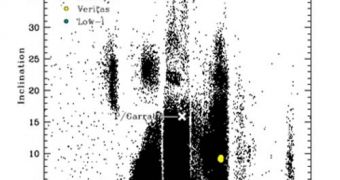The area of our solar system between Mars and Jupiter is known for its many asteroids, and for harboring some of the most peculiar planetary formations, such as the dwarf planet Ceres and the asteroid Vesta, all targets of NASA's New Dawn mission. However, back in 1996, astronomers observed a very weird object in the asteroid belt, one that had the orbital stability of an asteroid, and yet emitted a plume of gas and dust like a comet did. The new object was aptly named 133P, and astronomers proceeded towards theorizing that it represented a new class of cosmic bodies.
The find is made even more interesting by the fact that no other piece of rock in the inner asteroid belt was ever observed to spew gas or dust before or since. Or at least not until recently. For a long time, experts have pointed at only two explanations for 133P. One such idea said that the body was in fact a comet, which, due to a highly improbable combination of gravitational kicks and pulls from neighboring bodies, some planets and the Sun, became trapped in an asteroid-like orbit in the asteroid belt. However, the chances of this happening are next to zero, as evidenced by the fact that no other object has ever been known to do that before.
The second theory claimed that the 133P was an asteroid, which was made of large amounts of ice and dust. On account of the inevitable collisions that took place in the asteroid belt, it began to shed its matter. This also seemed highly unlikely, because no other objects of this type had been observed via telescopes before. Puzzled by this idea, astronomer Henry Hsieh, from Queen's University, in Belfast, Northern Ireland, set out to investigate it, performing some 657 observations of 599 asteroids in the inner belt.
After serious amounts of time spent at the observatory, he discovered another asteroid that also seemed to be emitting dust, which he gave the catchy name of 176P/LINEAR. The new find ended the controversy as to what 133P actually was. Although a very small chance remains that it is a comet stuck in a peculiar orbit, astronomers are now almost certain that this is not the case. The two asteroids now have a class of their own, and are an interesting new part of the asteroid “menagerie.”

 14 DAY TRIAL //
14 DAY TRIAL //